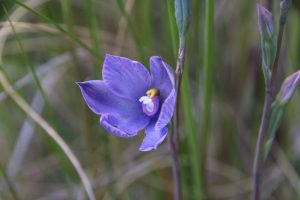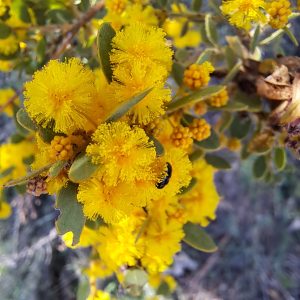
One of the new additions to the Flora list is the beautiful Mountain Sun Orchid, Thelymitra alpina, which usually occurs at higher altitudes and is now known to be on Mount Majura thanks to Peter Quinn who took the photograph and the Canberra Nature Map orchid experts who identified the species in November 2022.
We have recently updated the plant species list for Mount Majura and Mount Ainslie on the FoMM website – see here.
This past year we have added 33 new species and 14 of these are local native species.
Unfortunately this means that once again we have added many new exotic species – let’s hope that they don’t become invasive weeds.
The Friends of Mount Majura and the Mount Ainslie Weeders try to limit the spread of exotics by removing them as we discover them.
We always welcome extra helpers to our working bees to assist in this task of keeping our reserves free of the worst weeds.

Italian Arum seedlings growing near the Hackett tank where volunteers dug them out at the recent working bee (Photo W. Pix).
One of the new species which was found on both mountains this year is Italian Arum which has a reputation of being difficult to eradicate once it has established in an area. The orange fruits are attractive to birds; they spread the seed into the nature reserves. If you have this plant in your garden near one the reserves, dig it out carefully with its underground tubers and dispose it in the bin (do not place it in your compost); wear gloves when handling it as it can cause skin irritation.
It is easy to understand why we are finding new exotic plants in the reserves – our streets and gardens are so close to the nature reserve boundaries and they are full of thousands of exotic plants, many with invasive tendencies.
But why are we still finding new native plants after many years of observations? Some small plants may not be new at all but they may be not brightly coloured and easily overlooked. And some larger plants we know are there but they are difficult to identify, so we walk past them – things like the rushes in wet areas. Some keen observers began to take up the challenge of identifying them and some have now been added to our plant list. And possibly some are actually new to the area – species distributions will change as our climate changes.
One of the new addition to the Flora list is the beautiful Mountain Sun Orchid which usually occurs at higher altitudes and now it is known to be on Mount Majura (see feature image).

Grey Mulga (Photo B. Read).
Last spring Max found another beauty, the Grey Mulga wattle on Mount Majura’s northern slope and recorded it on Canberra Nature Map. It is one of the species where we are unsure how it found its own way here, but it does not seem to be invasive. It is mainly found to the west in mallee country, but does have a few records further east, so perhaps this sighting represents a new eastern outlier in its normal distribution. Thank you to Isobel Crawford for identifying it.
And here are two native grasses with really distinctive flower and seed heads which I think must have been in our reserves for many years but were only identified this last year.

Flowering Water Couch, Paspalum distichum with distinct purple anthers and feathery stigmata recorded on Campbell side of Mount Ainslie (photo T. Preston)
As you would guess from the name, the Water Couch likes wet areas. But it is Paspalum distichum, not a couch such as the the cosmopolitan couch grass Cynodon dactylon often found to invade Canberra lawns.

Barbed-wire Grass, Cymbopogon refractus is a clump-forming perennial warm season grass 1 m in height when in flower. It is most notable for its seed heads, which look like barbed-wire, hence the name (Photo C. Ernst-Russell)
Ciaran found Barbed-wire Grass, Cymbopogon refractus in the northern part of Mount Majura reserve in June – not flowering then but showing the wonderful weird structure of the seed head. Its other common name, Lemon Scented Grass, derives from the pleasant lemony scent of the crushed foliage. Other members of the Genus Cymbopogon are the Lemongrass C. citratus from Southeast Asia, well known for its culinary use in Asian kitchen, and the Citronella Grass, C. nardus which is used to produce mosquito repellent from its citronella oil.
This spring as you admire the wildflowers on Mount Majura keep looking for new plants, take photos if you see something unusual, and post them on Canberra Nature Map so everyone can enjoy them.
Barbara Read
September 2023


